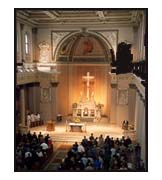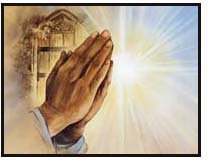American Catholic Press
16565 S. State Street, South Holland, Illinois 60473
|
||||||||||||||||||||||||
|
|
||||||||||||||||||||||||
|
by Bishop Joseph Perry Since the Second Vatican Council (1962-1965), we have succeeded in educating ourselves that we are the Church; that the Church, first off, is made up of people. People are more sacred than anything we value. It follows that the place where we believers assemble each week is sacred because we are a holy people.
In our more cynical moments, we may wonder how holy we really are.
Suffice it to say, we are called to holiness. Christian life features
consistent struggle to be the faith-filled, moral and just people
expected of our baptism.
The church building is indeed a special place. Public worship has always featured clothing, utensils, furniture and art given separate status for worship apart from the things we handle and use from day to day. These things are usually given a blessing or consecration to indicate their special usage. These sacred objects help place us in the proper disposition for worship. They essentially point to God and remind us of the spiritual world, the angels and the saints. Being sacred objects, we do not handle them as we handle objects not considered sacred. We give sacred space and sacred objects due reverence. And if they must be touched, there should be only a careful handling. We older Catholics will recall the older discipline when the Communion host was placed on the tongue and not in the hand; where there was a railing separating the congregation from the sanctuary; where the chalice, ciboria and altar linens came under the exclusive touch of the priests, notwithstanding special permission given certain nuns and sacristans whose job it was to set up for Mass; where hushed silence was the posture ordered in church to give credence to the true presence of Jesus in the tabernacle. Since the liturgical reforms of the council, worship space in Catholic churches, in many places, has been renovated to accommodate greater participation and familiarity with one another. Some modern church designs allow for transfer of the tabernacle with its eternal flame to visible and attractive chapels off the nave, thereby creating environments for greater movement, relaxed conversation and mutual contact. All these shifts are good. But what remains, if anything, of our tradition with a sense of the sacred? While we strive to see holiness first in each other, there is still room for an essential reverence paid the sacred place of the assembly and the objects, vessels and appointments used in worship. In fact, disrespecting the house may well indicate a disrespect for those who live in the house. For example, the altar is sacred because upon it rests the body and blood of Christ. The priests and deacons reverence (kiss) the altar at least twice during each Mass in homage to the sacred table. Hence, we never use the altar as a desk to sort papers, to rest upon or pile things on, even for the slightest moment.
At the sign of peace, with a genuine Christian joy involved in our
greeting and embrace, we are conscious, nevertheless, that we stand
in the presence of the Blessed Sacrament, an acknowledgment that
should preoccupy us similar to if Jesus walked in our midst and moved
among us. Men and boys appropriately remove their hats upon entering
church. A bow or genuflection is still appropriate upon entering
the pew when the tabernacle occupies center space or when we pass
by the tabernacle. Notice, a few of these manners are expected when
we visit museums, theaters and libraries. All this preoccupation with sacred space and sacred things serves only to remind us that we each are sacred. And coming together weekly to remember the Lord makes the space and the things we use sacred. We are not conscious of this, necessarily, working in the factory or at a desk with a computer. Worship, on the other hand, reminds us we are a holy people. Hopefully,
how we behave in church with one another can carry over to life outside
church so that life can be more humane and every man, woman and child
can be honored for the sacred beings they really are. Postures of
respect and reverence cannot help but model us for viewing all of
life as sacred. Who We Are | Where
We Are | Lectionary | Leaflet
Missal Copyright © 1999 American
Catholic Press. All rights reserved. |
|||||||||||||||||||||||
|
||||||||||||||||||||||||

 Our
Catholic faith embodies an ancient
principle of religion
called sacred space.
The building and areas where we exercise
the cult contain
objects and appointments
set aside for entertaining
God.
Our
Catholic faith embodies an ancient
principle of religion
called sacred space.
The building and areas where we exercise
the cult contain
objects and appointments
set aside for entertaining
God.  We live in a society which has discarded long held courtesies and
formalities connected with a lot of things. One commentary says
much of the former etiquette was stiff and out-of-date. Another
commentary says that even our popular enlightenment and education
nonetheless calls for certain time-honored gestures and attitudes
of respect. And we need a reverence for God, the things of God and
one another. We benefit by respect paid to our fellow believers.
We live in a society which has discarded long held courtesies and
formalities connected with a lot of things. One commentary says
much of the former etiquette was stiff and out-of-date. Another
commentary says that even our popular enlightenment and education
nonetheless calls for certain time-honored gestures and attitudes
of respect. And we need a reverence for God, the things of God and
one another. We benefit by respect paid to our fellow believers.